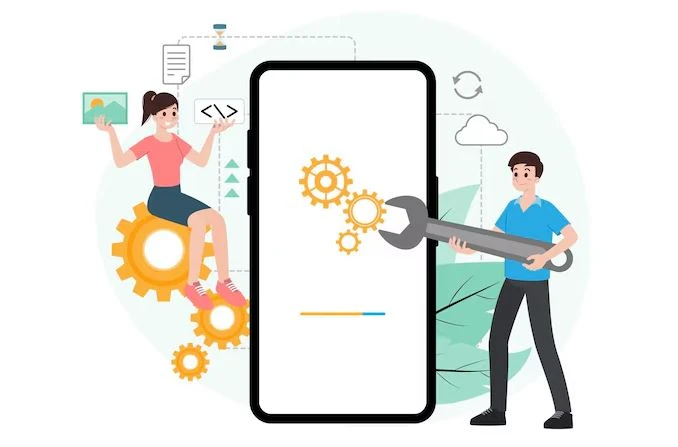Table of Content
Know the Factors That Could Scale up the App Maintenance Cost
The distinction between successful and unsuccessful apps lies not just in their initial development but also in the way they are maintained over time. An app’s long-term success depends heavily on continuous updates, performance optimization, security patches, and user feedback integration. Without proper maintenance, even the most well-designed applications can quickly become outdated, vulnerable to bugs, or irrelevant in a fast-moving digital landscape.
Every project manager needs to know how much does it cost to maintain an app because maintenance costs can vary widely due to several factors. These include the complexity of the app, the frequency of updates, third-party service integrations, hosting and infrastructure needs, and platform-specific requirements. Understanding these variables is essential for planning a sustainable maintenance strategy and ensuring that the app continues to deliver value to users while adapting to changing market demands.
In this blog, we will discuss in detail how much does it cost to maintain an app by working with professional software development services. Understanding this estimation is important as it allows you to prepare a long-term maintenance budget efficiently. Let’s start from the basics understanding why consistent app maintenance is important for businesses.
Importance of Consistent App Maintenance

Consistent app maintenance is crucial for businesses because it ensures optimal performance and reliability. Users expect apps to function smoothly without crashes, delays, or glitches. Regular maintenance helps identify and fix issues before they impact user experience, which is essential for retaining customers and building a strong reputation. Without consistent upkeep, even minor bugs can escalate into larger problems that disrupt service and lead to negative reviews or customer churn.
In addition to performance, app maintenance plays a significant role in security. The digital landscape is constantly evolving, with new vulnerabilities emerging regularly. Businesses must stay ahead of potential threats by updating software components, applying security patches, and monitoring for suspicious activity. Failing to do so can expose sensitive user data, lead to compliance issues, and result in costly breaches. A proactive maintenance strategy demonstrates a company’s commitment to data protection and user trust.
Consistent maintenance also allows businesses to remain competitive and aligned with market trends. This includes updating features based on user feedback, ensuring compatibility with new operating systems or devices. By continuously improving the app, businesses can adapt to user needs, stand out in a crowded market, and capitalize on new opportunities. Maintenance isn’t just about fixing what’s broken—it’s about driving growth, innovation, and long-term success.
How Much Does it Cost to Maintain an App: 5 Factors to Consider

Just like WordPress website cost, the cost of maintaining an app depends on various factors. It is recommended to remember all these points on fingertips, as that allows you to prepare the maintenance budget accordingly. Let’s take a look at few of them below.
Hosting Fees
Hosting fees are a significant component of app maintenance costs and can scale up or down depending on several usage-based factors. As your user base grows, so does the demand on your server resources—more data storage, bandwidth, and processing power are required to support increased traffic and functionality. This often leads to higher hosting fees, especially if you’re using cloud services that charge based on usage metrics.
Conversely, hosting fees can also decrease if the app experiences a reduction in user activity or if the infrastructure is optimized. Businesses can implement auto-scaling solutions, switch to more efficient hosting plans, or adopt server-less architecture to better manage costs. By closely monitoring and adjusting hosting resources, businesses can align their app maintenance costs with actual needs, avoiding overspending while maintaining performance.
New Features Integration
Integrating new features into an app can significantly increase maintenance costs, especially when those features add complexity to the system. Each new addition may require changes to the existing codebase, testing across different devices and platforms, and ongoing support to address potential bugs or compatibility issues. These new features also increase the scope of future updates, testing, and user support, all of which contribute to higher long-term maintenance costs.
On the other hand, strategically planned and modular feature integration can help control or even reduce maintenance expenses over time. By using scalable architecture and reusable code components, developers can implement new features with minimal disruption to existing systems. Additionally, integrating features based on user feedback and business priorities ensures that resources are focused on what truly adds value, reducing wasted effort on unnecessary updates.
Turn your concepts into mobile apps brimming with advanced features. From inception to deployment, make a distinct impact in the market.
Contact Now
Customer Support
Customer support plays a vital role in app maintenance costs, as it directly influences the resources needed to address user issues and maintain satisfaction. Support teams may need to collaborate with MVP developers to resolve issues, release patches, or provide detailed troubleshooting, all of which add to the overall maintenance workload. The more complex or unstable the app, the greater the dependency on customer support, making it a key factor in scaling maintenance expenses upward.
Conversely, effective customer support systems can help reduce maintenance costs over time. Implementing self-service tools, and in-app guidance can minimize the need for direct human assistance, lowering operational costs. Furthermore, using support interactions to gather user feedback can help identify recurring problems or opportunities for improvement early on. This proactive approach not only enhances user experience but also streamlines maintenance by addressing issues before they escalate.
Development Platform
The choice of development platform has a direct impact on the scalability and cost of app maintenance. Most platforms that support ecommerce software development allow developers to maintain a single codebase for both iOS and Android, reducing the time, effort, and costs associated with updates and bug fixes. Additionally, platforms with strong community support and extensive libraries can speed up development and troubleshooting, further lowering maintenance demands.
However, the wrong development platform choice can increase maintenance costs over time. If the platform becomes outdated, ongoing support and updates become more challenging and expensive. Proprietary or niche platforms may also lead to vendor lock-in, limiting flexibility and requiring specialized expertise that can be costly to source. Therefore, selecting a widely adopted, well-supported, and scalable platform is crucial for maintaining long-term cost efficiency in app maintenance.
Frequent Updates
Apps that receive frequent updates typically demand more resources for ongoing maintenance compared to those updated less often. Each update involves a series of tasks, including modifying the code, conducting quality assurance tests, and ensuring compatibility across various devices and operating systems. These steps require skilled personnel, time, and tools, all of which contribute to higher maintenance costs.
Moreover, the process of deploying updates isn’t just about pushing new features, it includes thorough mobile app testing to ensure the changes don’t introduce new bugs or disrupt existing functionality. Testing must cover different environments and user scenarios, especially if the app operates on both iOS and Android platforms. This complexity can lead to longer development cycles and greater maintenance cost.
Frequently Asked Questions
| What is app maintenance cost? App maintenance cost refers to the ongoing expenses required to keep a mobile application functional, secure, and up to date. It includes costs for updates, bug fixes, performance optimization, hosting, and user support. |
| What makes an app expensive? An app becomes expensive due to factors like complex features, custom design, cross-platform development, and integration with third-party services. Ongoing maintenance, security requirements, and frequent updates also contribute to higher costs. |
| How hosting fees can scale up app maintenance cost? Hosting fees can scale up app maintenance costs as user traffic, data storage, and server demands increase. More advanced features or real-time functionality often require higher-capacity infrastructure, leading to greater expenses. |
Final Words
That concludes our entire article in which we have discussed all the key factors that could scale up the cost of app maintenance. Being a project stakeholder or manager, it is important for you to note down these factors. Many times, businesses do not pay attention to these little things which basically swells up the maintenance cost. They become more evident for enterprise apps that require larger resources to build and manage various features. It is therefore recommended to keep an eye on all these factors, as they could help you to formulate a reasonable budget for long-term app maintenance.
Empower your digital initiatives with BariTechSol, a premier custom software development company. Our skilled team tailors cutting-edge solutions to your unique needs. Elevate your tech experience and stay ahead in the digital realm. Partner with BaritechSol and code the success of your next big idea.


